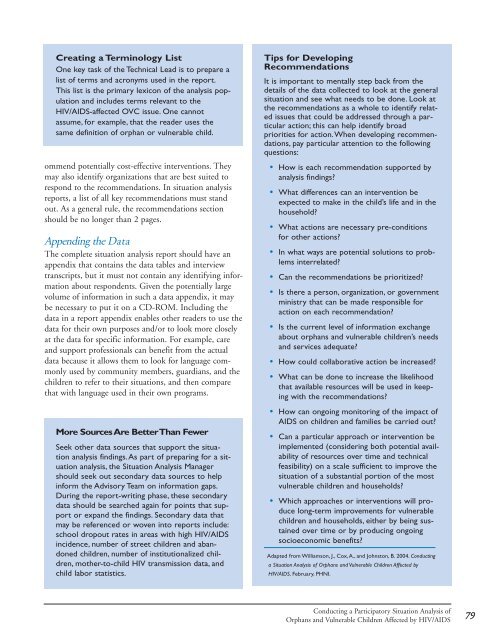Conducting a Participatory Situation Analysis of.pdf - Global HIV ...
Conducting a Participatory Situation Analysis of.pdf - Global HIV ...
Conducting a Participatory Situation Analysis of.pdf - Global HIV ...
You also want an ePaper? Increase the reach of your titles
YUMPU automatically turns print PDFs into web optimized ePapers that Google loves.
Creating a Terminology List<br />
One key task <strong>of</strong> the Technical Lead is to prepare a<br />
list <strong>of</strong> terms and acronyms used in the report.<br />
This list is the primary lexicon <strong>of</strong> the analysis population<br />
and includes terms relevant to the<br />
<strong>HIV</strong>/AIDS-affected OVC issue. One cannot<br />
assume, for example, that the reader uses the<br />
same definition <strong>of</strong> orphan or vulnerable child.<br />
ommend potentially cost-effective interventions. They<br />
may also identify organizations that are best suited to<br />
respond to the recommendations. In situation analysis<br />
reports, a list <strong>of</strong> all key recommendations must stand<br />
out. As a general rule, the recommendations section<br />
should be no longer than 2 pages.<br />
Appending the Data<br />
The complete situation analysis report should have an<br />
appendix that contains the data tables and interview<br />
transcripts, but it must not contain any identifying information<br />
about respondents. Given the potentially large<br />
volume <strong>of</strong> information in such a data appendix, it may<br />
be necessary to put it on a CD-ROM. Including the<br />
data in a report appendix enables other readers to use the<br />
data for their own purposes and/or to look more closely<br />
at the data for specific information. For example, care<br />
and support pr<strong>of</strong>essionals can benefit from the actual<br />
data because it allows them to look for language commonly<br />
used by community members, guardians, and the<br />
children to refer to their situations, and then compare<br />
that with language used in their own programs.<br />
More Sources Are Better Than Fewer<br />
Seek other data sources that support the situation<br />
analysis findings.As part <strong>of</strong> preparing for a situation<br />
analysis, the <strong>Situation</strong> <strong>Analysis</strong> Manager<br />
should seek out secondary data sources to help<br />
inform the Advisory Team on information gaps.<br />
During the report-writing phase, these secondary<br />
data should be searched again for points that support<br />
or expand the findings. Secondary data that<br />
may be referenced or woven into reports include:<br />
school dropout rates in areas with high <strong>HIV</strong>/AIDS<br />
incidence, number <strong>of</strong> street children and abandoned<br />
children, number <strong>of</strong> institutionalized children,<br />
mother-to-child <strong>HIV</strong> transmission data, and<br />
child labor statistics.<br />
Tips for Developing<br />
Recommendations<br />
It is important to mentally step back from the<br />
details <strong>of</strong> the data collected to look at the general<br />
situation and see what needs to be done. Look at<br />
the recommendations as a whole to identify related<br />
issues that could be addressed through a particular<br />
action; this can help identify broad<br />
priorities for action.When developing recommendations,<br />
pay particular attention to the following<br />
questions:<br />
• How is each recommendation supported by<br />
analysis findings?<br />
• What differences can an intervention be<br />
expected to make in the child’s life and in the<br />
household?<br />
• What actions are necessary pre-conditions<br />
for other actions?<br />
• In what ways are potential solutions to problems<br />
interrelated?<br />
• Can the recommendations be prioritized?<br />
• Is there a person, organization, or government<br />
ministry that can be made responsible for<br />
action on each recommendation?<br />
• Is the current level <strong>of</strong> information exchange<br />
about orphans and vulnerable children’s needs<br />
and services adequate?<br />
• How could collaborative action be increased?<br />
• What can be done to increase the likelihood<br />
that available resources will be used in keeping<br />
with the recommendations?<br />
• How can ongoing monitoring <strong>of</strong> the impact <strong>of</strong><br />
AIDS on children and families be carried out?<br />
• Can a particular approach or intervention be<br />
implemented (considering both potential availability<br />
<strong>of</strong> resources over time and technical<br />
feasibility) on a scale sufficient to improve the<br />
situation <strong>of</strong> a substantial portion <strong>of</strong> the most<br />
vulnerable children and households?<br />
• Which approaches or interventions will produce<br />
long-term improvements for vulnerable<br />
children and households, either by being sustained<br />
over time or by producing ongoing<br />
socioeconomic benefits?<br />
Adapted from Williamson, J., Cox,A., and Johnston, B. 2004. <strong>Conducting</strong><br />
a <strong>Situation</strong> <strong>Analysis</strong> <strong>of</strong> Orphans and Vulnerable Children Affected by<br />
<strong>HIV</strong>/AIDS. February. PHNI.<br />
<strong>Conducting</strong> a <strong>Participatory</strong> <strong>Situation</strong> <strong>Analysis</strong> <strong>of</strong><br />
Orphans and Vulnerable Children Affected by <strong>HIV</strong>/AIDS<br />
79















